
As November approaches, millions of Americans are anxiously waiting to know if the Trump administration will continue providing crucial food assistance through the Supplemental Nutrition Assistance Program (SNAP). Here's everything you need to know about the current status of food benefits.
What Exactly Are SNAP Benefits?
SNAP, commonly known as food stamps, represents a federal assistance program designed to help low-income individuals and families purchase nutritious food. This program serves as a vital safety net for vulnerable populations across the United States.
Will November Bring SNAP Payments?
The burning question on everyone's mind: Will the Trump administration authorize SNAP benefits for November 2023? While official confirmation is pending, historical patterns suggest that regular SNAP benefits will likely continue, though pandemic-era additional payments remain uncertain.
Top 10 Frequently Asked Questions
1. How Do I Apply for SNAP Benefits?
Applications can be submitted through your state's SNAP office, either online, in person, or by mail. Each state maintains its own application process and eligibility requirements.
2. What Are the Income Eligibility Requirements?
Eligibility depends on household size, income, and expenses. Generally, households must meet both gross and net income tests, though elderly or disabled members might have different criteria.
3. How Much Assistance Can I Receive?
Benefit amounts vary based on household size, income, and allowable deductions. The maximum benefit for a family of four is currently set at $939 per month.
4. When Are Benefits Distributed?
Distribution dates differ by state and are typically staggered throughout the month. Benefits are loaded onto Electronic Benefit Transfer (EBT) cards, which function like debit cards.
5. What Can I Purchase with SNAP Benefits?
Eligible items include fruits, vegetables, meat, poultry, fish, dairy products, breads, cereals, and other food products. Alcohol, tobacco, vitamins, and hot prepared foods are excluded.
6. Can College Students Qualify?
Students enrolled at least half-time may qualify if they meet specific criteria, such as working a minimum number of hours or participating in work-study programs.
7. How Long Do Benefits Last?
Certification periods typically range from 6 to 24 months, depending on state policies and individual circumstances. Recipients must recertify before their period ends.
8. What About Emergency SNAP Benefits?
Some states offer expedited benefits for households with very low income and resources, often available within seven days of application.
9. Are Immigrants Eligible?
Eligibility for immigrants varies based on immigration status, with qualified aliens potentially eligible after meeting certain residency requirements.
10. How Has COVID-19 Affected SNAP?
The pandemic led to temporary increases in benefit amounts and expanded eligibility, though many emergency measures have since expired or are being phased out.
Looking Ahead: What to Expect
While the future of enhanced SNAP benefits remains uncertain, the core program continues to provide essential support to millions of Americans. Stay informed by regularly checking your state's SNAP website and official government portals for the latest updates.
Remember: SNAP benefits represent more than just financial assistance—they're a crucial investment in public health and family stability during challenging economic times.





